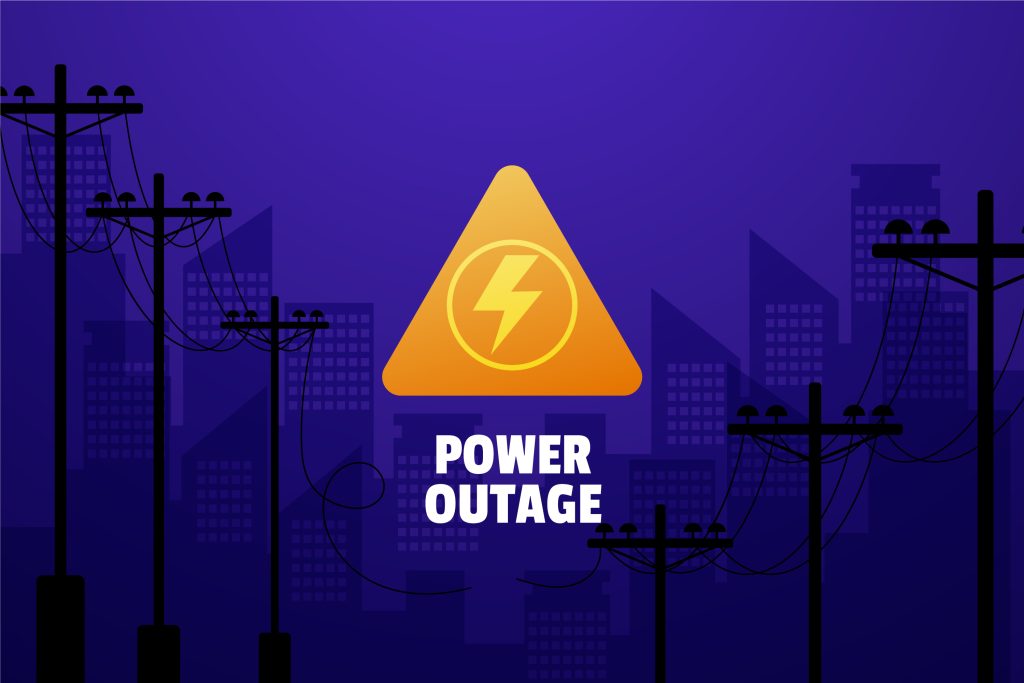At a glance
- Australia’s weather, wildlife, and demand overload on the grid are common causes of power outages.
- Be prepared with a charged phone, battery-powered radio, and knowledge of your provider’s communication channels.
- Select & Switch can help you choose an electricity provider known for responsiveness during outages.
Living in Australia, we’ve all experienced the frustration of a sudden power outage. Whether it’s a brief flicker during a storm or a prolonged blackout, understanding the causes can help you prepare and stay calm during these disruptions.
Here’s a look at the five main culprits behind power outages in Australian cities:
When the Weather Goes Bananas
Our country’s crazy weather can wreak havoc on the power lines. Here’s how:
Stormy Nights
Buckle up for bucketing rain, Melbourne’s infamous ‘southerly busters’, and lightning strikes – a recipe for power woes. Wind can topple power poles or fling debris that damages them, causing outages that might affect your whole neighbourhood or your street. Lightning strikes can cause power surges or trip transformers, leading to localised blackouts.
Be Prepared: Watch the weather warnings, especially during storm season. Charge your phone and essential devices beforehand. Stock up on batteries for the TV or a good old-fashioned battery-powered radio to stay updated on any warnings from the Bureau of Meteorology. Getting surge protectors for your fancy electronics to shield them from voltage spikes during electrical storms.
Heatwave Woes
Scorching temperatures really strain the power grid, especially during peak usage times (usually early evening between 4 pm and 8 pm). When everyone cranks up the air-con to escape the heat, transformers can get overloaded, leading to rolling blackouts to prevent a larger power failure.
Be Prepared: Be a champion for the environment and your wallet! During heatwaves, try to use less electricity. Turn off lights in rooms you’re not using,and embrace low-tech solutions like cooling showers and ceiling fans. Some electricity companies offer “time-of-use” billing plans that give you discounts for using power during off-peak hours, so you can cool down your home before the peak usage window hits.
Bushfire Safety
Power outages can be a deliberate safety measure for our mates living in bushfire-prone areas. Power companies might shut off the electricity to prevent damaged power lines from sparking fires, potentially saving lives and homes. This is a common occurrence in Victoria, New South Wales and South Australia during bushfire season and when there are natural disasters.
Be Prepared: During bushfire season, stay informed about fire risks and evacuation warnings issued by emergency services. A battery-powered radio, a well-stocked emergency kit with non-perishable food and water, and a torch (flashlight) are crucial during bushfires and power outages.
When Aussie Wildlife Causes Power Outages
Living in Australia, we share our homes with some incredible wildlife. But sometimes, these furry (or feathery) friends can cause a bit of chaos – especially when it comes to our electricity!
Let’s delve into two main ways our unique wildlife can unintentionally disrupt our power supply:
Curious Critters on the Highwire
Our native possums, snakes, and even birds can sometimes become unintentional conductors. Here’s how:
Bridging the Gap: These curious creatures might climb or fly too close for comfort near power lines or transformers. Their bodies can bridge the gap between live wires, causing a short circuit. This unexpected connection creates sparks and disrupts the flow of electricity, leading to power outages that might affect your entire street or your house.
Be Prepared: A little prevention goes a long way. Keep tree branches trimmed away from power lines to deter animals from using them as highways. If you see any damaged lines or suspect wildlife interference, report it immediately to your electricity provider. Their trained professionals can assess the situation and ensure everything is safe.
Rodents Chewing the Problem at the Root
Those cute and cuddly rodents we see scampering around might have a hidden talent for causing power outages. Here’s why:
Cable Chewers: Rats and mice, bless their tiny hearts, have a penchant for chewing on anything they can get their teeth into. Unfortunately, electrical cables are not excluded from this nibbling habit. These little chewers can damage underground electrical wires or those within buildings, causing disruptions to the power supply and even a loss of power.
Be Prepared: Fight back against the furry saboteurs. Seal up any potential entry points for these tiny troublemakers around your home. This includes gaps around pipes, under doors, and in crawl spaces. By keeping them out, you can help prevent them from reaching the electrical wiring and causing an outage.
The Power Struggle: When Demand Outpaces Supply or Age Catches Up
Keeping the lights on isn’t always a given, especially when our electricity grid faces challenges. Here, we explore two main reasons why our power supply can sometimes sputter and lead to outages:
Grid Overload: Too Much Demand, Not Enough Supply
Imagine a highway packed with cars – that’s what can happen to our power grid during peak electricity usage. Here’s how:
Peak Power Hours: Sweltering summer days and chilly winter nights often surge electricity demand. Everyone cranks up the air conditioners or heaters, straining the grid’s capacity. If too much electricity is drawn at once, transformers can overload, leading to controlled blackouts to prevent power failure and protect the entire grid from damage.
Be Prepared: We can all be energy warriors. Simple steps like switching off lights in unoccupied rooms and using energy-efficient appliances can help reduce the overall demand on the grid. Explore “time-of-use” billing plans offered by some electricity retailers. These plans reward you for shifting your energy usage to off-peak hours, like early mornings or late evenings, when there’s less overall demand.
Infrastructure Issues: When Age Takes a Toll
Our electricity grid is a vast network; just like anything that’s been around for a while, parts of it inevitably age. Here’s how it can affect us:
Worn-out Electrical Infrastructure: Transformers, substations, and power lines are all crucial components of the grid. Over time, these components can wear out and become more susceptible to failure. Worn-out transformers may not be able to handle peak loads, while ageing power lines or substations can experience malfunctions, leading to localised loss of electricity or even complete loss and widespread outages impacting homes and businesses.
Be Prepared: While we can’t directly control infrastructure issues, there are ways to stay informed. Check your electricity provider’s website or social media for updates on planned maintenance outages in your area. This allows you to prepare for disruptions and minimise any inconvenience.
Equipment Malfunction: When Technology Takes a Tumble
Even the most sophisticated technology isn’t immune to occasional hiccups. Here’s how malfunctions at power stations or substations can sometimes disrupt our electricity supply:
Component Breakdowns: Technical glitches or breakdowns at power stations or substations can cause localised or widespread outages. These malfunctions can involve transformers, generators, or other critical electrical components.
Be Prepared: Similar to infrastructure issues, there’s little you can directly control here. However, staying updated on planned maintenance or unexpected outages through your electricity provider’s website or social media can help ease the inconvenience.
Accidental Damage: When the Unexpected Happens
Accidents, although uncommon, can also be a cause of power outages:
Traffic Mishaps: Car accidents involving power poles or underground cables can disrupt the electricity supply in the surrounding area. Damage to these critical components can cause outages until repairs are completed.
Be Prepared: There’s no direct way to prevent these accidents. However, staying informed about traffic disruptions through traffic apps or radio broadcasts can help you plan your day accordingly, especially during peak hours.
Remember:
- Compile an emergency kit that includes a battery-powered radio, torches (flashlights), a first-aid kit, bottled water, and non-perishable food items.
- Consider alternative lighting sources like battery-powered lamps or candles (use candles with caution).
- Have a plan to charge your phone during extended outages. This could involve a car charger, portable power bank, or solar charger (weather permitting).
- Identify a designated meeting place for your family in case you’re separated during an outage.
While a power outage can be disruptive, understanding the reasons behind them can help you stay calm and prepared. You can minimise inconvenience during an outage by taking some simple precautions, like keeping a charged phone and a battery-powered radio on hand. Stay informed about planned maintenance or unexpected outages through your electricity provider’s website or social media is vital.
Comparison sites and tools like Select & Switch can also help you choose an electricity provider most responsive to your needs during outages, even if the exact cause remains unknown. So, next time the lights go out, you’ll be a blackout pro!
-
Comprehensive insights into the energy bill relief fund in Australia
5 May 2024
Energy
-
Find the best electricity deal for electric vehicle charging
28 April 2024
Gas & Electricity
-
Understanding energy demand charges: A guide for business owners
25 April 2024
Energy


